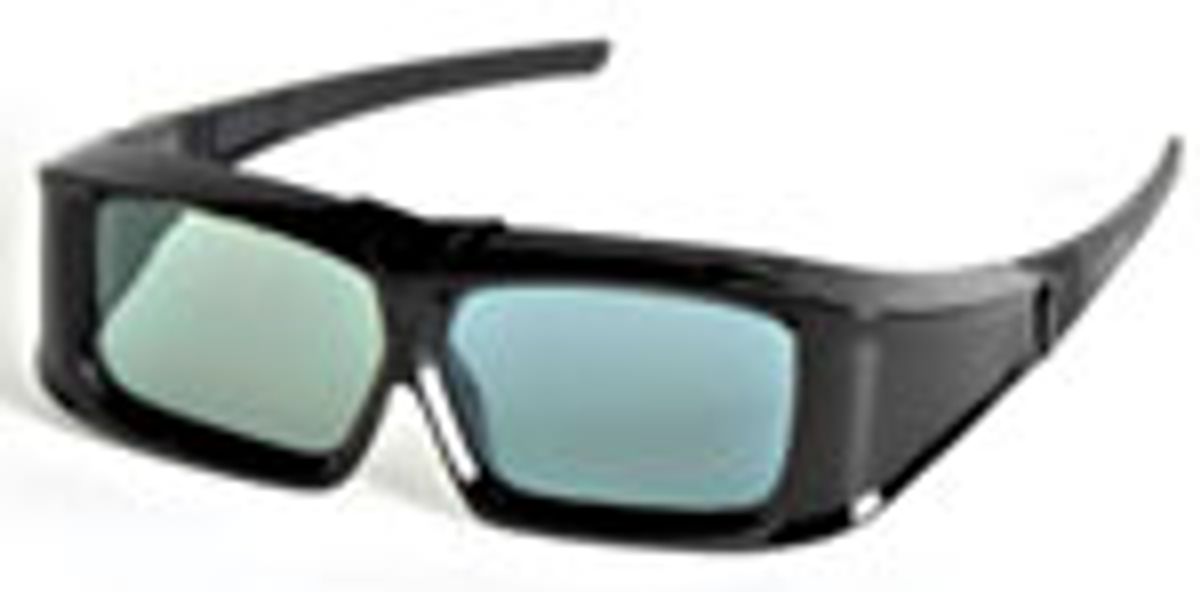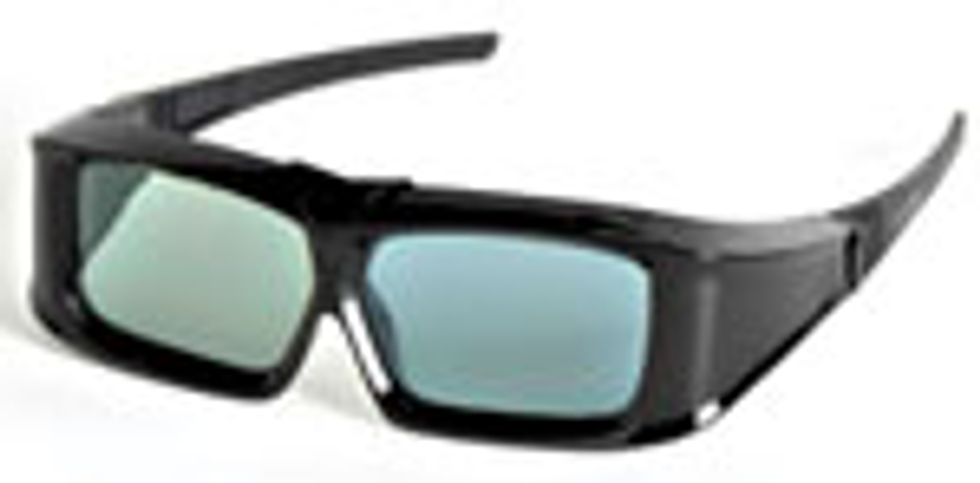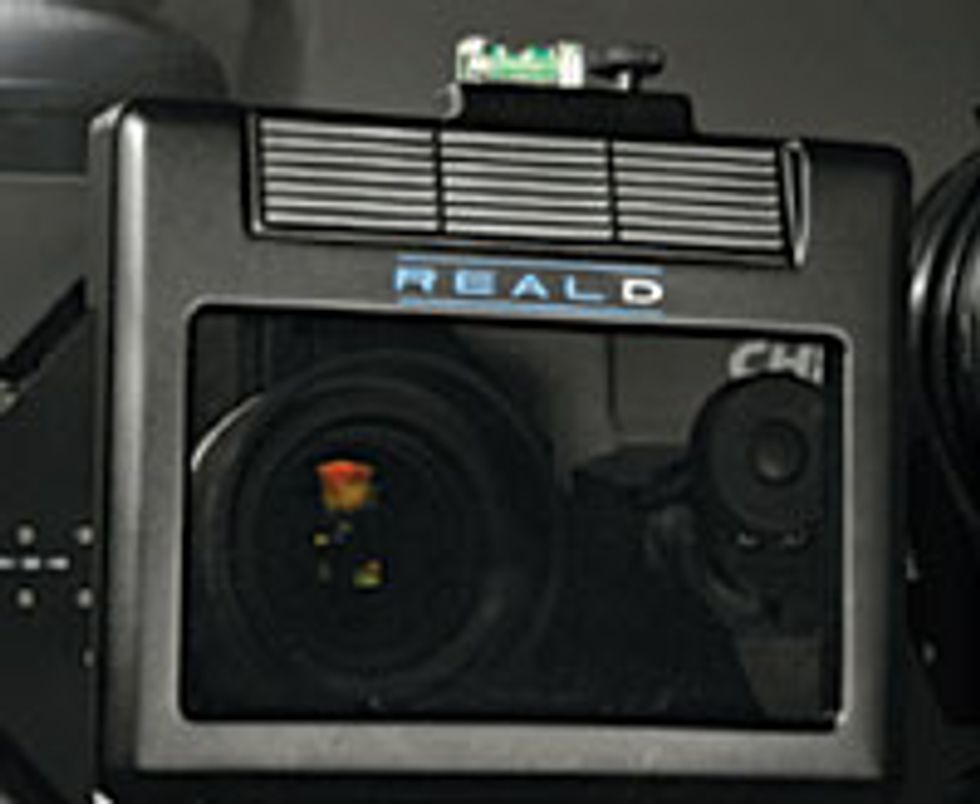In 1954, a few thousand households around the United States—with the equivalent of US $10 000 in today’s money to spare—bought the world’s first color television sets, from RCA, Westinghouse, and Admiral. Few shows were broadcast in color, and most people wrote it off as an expensive gimmick.
The right eye receives only light waves rotating clockwise, and the left eye gets them counterclockwise.
COORDINATES
The liquid-crystal filter in front of the projector lens switches states 144 times per second—letting through only circular clockwise-polarized light, then counterclockwise, then clockwise, and so on. The filter is synced with the projector so that the image for the right eye is projected when the filter lets through clockwise-polarized light; the image for the left eye is projected when the filter lets through counterclockwise-polarized.
2010 is 1954 all over again, but this time with 3-D. Pricey televisions are showing up in only a handful of homes. Movies in 3-D are doing well at the box office, but none are being broadcast, and many observers are writing off 3-D in the home as an overpriced and overly complicated gimmick. “3-D is a waste of a perfectly good dimension,” film critic Roger Ebert wrote in May.
Will the early 3-D adopters get the last laugh, just like the early color TV advocates? A definitive answer would require 4-D glasses to see into the next decade. But between 3-D movies and sports programming—notably the World Cup—and major product investments by the likes of Panasonic, Samsung, and Sony, not just in televisions but also in Blu-ray players, set-top boxes, and other gadgets, it’s time to ask the question: What does it take, in time, money, and effort, to put 3-D in your living room?
The answer begins with the glasses.
When you went to see Avatar, Toy Story 3, or Alice in Wonderland, chances are the usher handed you a pair of Polaroid-style “passive” lenses that let vertically polarized light enter the left eye and horizontally polarized light into the right. Or, like RealD’s Ray-Ban–like glasses, they used circularly polarized light, in which light waves rotating clockwise pass through the right eyeglass lens while counterclockwise ones pass into the left. Either method results in the illusion of a stereoscopic image onscreen [see sidebar, "Eye Fidelity," at right].
Passive 3-D is great for theater owners, because the glasses are cheap—in bulk, less than $1 per pair. It’s pricier in the home, though, because it puts all the complexity in the TV. As of press time (mid-July), South Korea–based LG Electronics had announced the only passive-display consumer 3-D model—its 47-inch LCD screen LD950.
Every other 3-D television set puts the complexity in the glasses, which turn dark over one eye for 8.3 milliseconds while showing the other eye an image. Then for the next 8.3 ms the glasses darken for the second eye while showing the first eye a complementary image. Together these images make up a stereoscopic picture. As far as the relatively slow human nervous system is concerned, the 16.6-ms interval takes place at the same instant. This happens 60 times per second, and it’s how “active” 3-D glasses trick the brain into perceiving stereoscopic depth from a flat screen. At $150 to $200 per pair, these battery-powered, microprocessor-equipped LCD glasses turn out to be one of the more expensive components of the 3-D living room, because you’ll need one pair per set of eyes—up to $800 for a classic nuclear family.
Pretty much any TV on the market today can be made into a 3-D TV, as long as the screen refreshes 240 times per second, which is commonly the case for high-end flat-panel models. According to Brian Markwalter, vice president of research and standards of the Consumer Electronics Association, what puts the 3-D in 3-D TV is an infrared syncing beacon, usually above the screen, that sends out electronic chirps every 8.3 ms, telling the glasses when to darken one lens and lighten the other. Thus the TV sends 120 images per second, but each unique frame gets refreshed twice with some video processing to smooth the motion and get rid of the trailing effect that LCDs have had in the past, Markwalter says.
At the moment, unfortunately, no signaling standard exists. That means the glasses you bought for your first-generation Samsung might not work on your friend’s first-gen Sony. Markwalter says he’s working with manufacturers on a universal standard that they hope to finalize by the end of the year. The hitch is that manufacturers want wiggle room in active eyewear standards. For example, they’d like their TVs to be able to run 2-D video games that can simultaneously show two players completely different scenes from the same 3-D TV panel. This complicates the standardization process for Markwalter and his committee. And, as ever, it makes video games a story unto themselves [see “3-D Video Games” at the end of this section].
In the world of noninteractive content, fortunately, the dust has all but settled. In December, the Blu-ray Disc Association released specs for full 1080p HD 3-D Blu-ray discs, which existing late-model Blu-ray players, such as the Sony BDP-S470, will support with a free firmware upgrade. (New 3-D Blu-ray players, such as Samsung’s BD-C6900XAA or Panasonic’s DMP-BDT350, support the 3-D standard out of the box.) That will give Blu-ray a leg up on cable and satellite set-top boxes, which will also be delivering 3-D to the home but not in full high-definition.
So for instance, in June DirecTV began offering a free upgrade to its receivers that horizontally squeezes each frame to fit more information—a little like CinemaScope did for wide-screen movies in the 1950s and ‘60s. A full HD frame is 1920 pixels wide by 1080 pixels high. But with 3-D, the left and right eye each gets its own dedicated frame. So DirecTV’s “side-by-side 3-D” broadcast protocol displays first a lower-resolution frame for the left eye (at 960 by 1080) and then a lower-resolution frame for the right eye. Markwalter said that widespread full HD 3-D cable and satellite broadcasts (that is, 1920 by 1080 to both eyes, as 3-D Blu-ray offers now) is still years off.
The ultimate dominance of 3-D in the marketplace seems assured. Scott Steinberg, head of the Seattle-based technology consulting firm TechSavvy Global, says, “The question is the speed of adoption. I can guarantee you that manufacturers are way more bullish than actual end users themselves.” Marquee 3-D movies like Avatar or Toy Story 3 on Blu-ray may draw curious onlookers to the Best Buy showroom floor to check out 3-D TV setups. But Steinberg doesn’t think consumers will make big purchase decisions based on a limited library of 3-D feature films alone. His best guess at widespread adoption: five to seven years hence.
Sports will be the biggest 3-D TV selling point in the coming year, Steinberg says. In addition to the World Cup, golf’s Masters Tournament was broadcast in 3-D in April, as was baseball’s All-Star Game in July. ESPN’s newly launched 3-D channel, promising at least 80 events in its first year, could draw nongeeks into the 3-D net. “Sporting events were the killer app for high-definition television,” says Steinberg. “I have no reason to doubt that it wouldn’t be the same for 3-D TV.” Still, he wonders if enough HD buyers will still feel enough techno-lust to go on a 3-D spending spree. “Customers are being asked to make a second leap of faith in the middle of one of the worst economic crises in history,” he says.
To be sure, the switch to 3-D isn’t all-or-nothing. Shawn DuBravac, chief economist of the Consumer Electronics Association, says a 3-D TV setup is ultimately still just a nice HD screen with some fancy glasses. As the marginal cost between HD and 3-D drops, he says, 3-D will become just another add-on in any home theater system.
“The key with 3-D is it’s largely a feature,” DuBravac says. “If somebody doesn’t want to use it, they don’t have to. But the option is there for them.”


